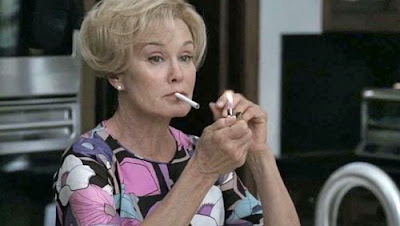Dennis Cozzalio and I are going to recap American Horror Story's first season at our respective blogs. Each Monday, one of us will will start the discussion and we'll go back-and-forth on our respective blogs. I am posting my first post on "Halloween, Part 2" here, but you can also follow along with our conversation at Sergio Leone and the Infield Fly Rule. Read on for some more of my thoughts on the fifth episode of season one.
******
Oh, hullo, Dennis.
So, as promised, I've finally started to come around on American Horror Story. I've kept with the show because I've hoped it would get as good as and then better than the standard set by "Pilot." Now, I think "Halloween, Part 2" is probably the best episode of the series thus far. Granted, we're only five episodes in, but shut up, that's why.
Anyway, I rewatched "Halloween, Part 2" so that this introductory post would be a little more detailed than my previous plot synopses have been. And as I rewatched it, I got a better handle on what I liked about this episode and why it mattered more to me than what I disliked. A good part of what I liked can be credited to episode director David Semel, who not only paces "Part 2" with great care, but also shoots it with an eye for negative space, and an artful use of natural lighting and extreme close-ups.
Anyway, I rewatched "Halloween, Part 2" so that this introductory post would be a little more detailed than my previous plot synopses have been. And as I rewatched it, I got a better handle on what I liked about this episode and why it mattered more to me than what I disliked. A good part of what I liked can be credited to episode director David Semel, who not only paces "Part 2" with great care, but also shoots it with an eye for negative space, and an artful use of natural lighting and extreme close-ups.
Generally speaking, I also found the way that various characters' arcs were immediately resolved in this episode to be satisfying. Addy's dead, so now Constance can, to paraphrase Manohla Dargis's review of Premium Rush, let a little light into her storyline (ie: be more than an ostensibly complex but mostly just lovably catty old crone). Thanks to Hayden, Ben is forced to accept that he can't superhumanly hold his family together. And thanks to Violet's increased interest in him, Tate's past is revealed just a little more. All of these revelations would not be as satisfying as they are without Semel's direction, I think. He's got my vote for MVP of "Halloween, Part 2," easy.
















